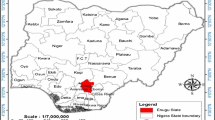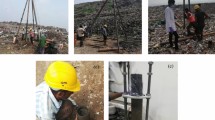Abstract
Recycling, neutralization and storage of solid household waste is an urgent problem due to the constant growth of their accumulation. When they are stored outdoors, as the result of mechanical, chemical and biological weathering, chemical elements become mobile and migrate to surrounding areas, creating soil, hydrochemical and biological anomalies. Some of the elements form secondary minerals (salts, oxides-hydroxides, chlorides, phosphates) or are part of the organic component of landfill soil. In the young soils (2 years old), accumulate high values of total carbon, humus, N, and H. The number of microbial cells in them is less than in the old ones (20 years old), but their diversity is greater. In young landfill soils, high concentrations of most chemical elements (Zc = 74) recorded in comparison with the settled soils (Zc = 32). The degree of weathering of 20-year-old soils is 10–100 times greater compared to young landfill soils. Most of elements accumulate in the soil filtrate of young sediments (from 2 to 15 times) compared to the settled soils.
Access this chapter
Tax calculation will be finalised at checkout
Purchases are for personal use only
Similar content being viewed by others
References
Assamoi B, Lawryshyn Y (2012) The environmental comparison of landfilling vs. incineration of MSW accounting for waste diversion. Waste Manag. 32 (5): 1019–1030 https://doi.org/10.1016/j.wasman.2011.10.023
Basha BM, Parakalla N, Reddy KR (2016) Experimental and statistical evaluation of compressibility of fresh and landfilled municipal solid waste under elevated moisture contents. Int. J. Geotech. Eng. 10 (1): 86–98 https://doi.org/10.1179/1939787915Y.0000000018
Boyanov B, Peltekov A, Petkova V (2014) Thermal behavior of zinc sulfide concentrates with different iron content at oxidative roasting. Thermochim. Acta. Vol. 586. 9–16
Burlakovs J, Kaczala F, Vincevica-Gaile Z, Rudovica V, Orup ̃old K, Stapkevica M, Bhatnagar A, Kriipsalu M, Hogland M, Klavins M, Hogland W (2016) Mobility of metals and valorization of sorted fine fraction of waste after landfill excavation. Waste Biomass Valorization 7:593–602 https://doi.org/10.1007/s12649-016-9478-4
Chen Y, Zhan TL, Ling W-A (2008) Mechanical properties of municipal solid waste from Suzhou landfill in China. In: GeoCongress 2008: Geotechnics of Waste Management and Remediation, New Orleans, United States, pp. 160–167 https:// doi.org/https://doi.org/10.1061/40970(309)20
Chen Y, Xu WJ, Ling DS, Zhan LT, Gao W (2020) A degradation–consolidation model for the stabilization behavior of landfilled municipal solid waste. Comput. Geotech. 118:103341 https://doi.org/10.1016/j.compgeo.2019.103341
Dixon N, Jones DRV (2005) Engineering properties of municipal solid waste. Geotext. Geomembr. 23 (3):205–233 https://doi.org/10.1016/j.geotexmem.2004.11.002
Dobrovolsky, V (1983) Geography of trace elements: Global scattering. 174 p
Hadinata F, Damanhuri E, Rahardyan B, Widyarsana IMW (2018) Identification of initial settlement of municipal solid waste layers in Indonesian landfill. Waste Manage. Res. 36 (8): 737–743 https://doi.org/10.1177/0734242X18788149
Hull RM, Krogmann U, Strom PF (2005) Composition and characteristics of excavated materials from a New Jersey landfill. J. Environ. Eng. 131:478–490. https://doi.org/10.1061/(ASCE)0733-9372(2005)131:3(478)
Jo Y-S, Jang Y-S (2021) Comparison of waste settlement characteristics for two landfills disposed in long sequential periods. Waste Manage. 131:433–442. https://doi.org/10.1016/j.wasman.2021.07.003
Liu SJ, ** BD, Qiu ZP, He XS, Zhang H, Dang QL, Zhao XY, Li D (2019) Succession and diversity of microbial communities in landfills with depths and ages and its association with dissolved organic matter and heavy metals Sci. Total. Environ, 651:909-916 https://doi.org/10.1016/j.scitotenv.2018.09.267
Olszak-Humienik M, Mozejko J (1999) Kinetics of thermal decomposition of dolomite. J. Therm. Anal. Calorim. Vol. 56: 829–833
Santos VHJM, Engelmann AdM, Marconatto L, Borge LGdA, Palhano Adl, Augustin AH, Rodrigues LF, Ketzer JMM, Giongo A (2022) Exploratory analysis of the microbial community profile of the municipal solid waste leachate treatment system: A case study. Waste Manag, 141:125–135 https://doi.org/10.1016/j.wasman.2022.01.014
Song L, Wang Y, Tang W, Lei Y (2015) Bacterial community diversity in municipal waste landfill sites. Appli. Microbio. Biotechnol 99:7745–7756 https://doi.org/10.1007/s00253-015-6633-y
Speier CJ, Mondal MM, Weichgrebe D (2018) Evaluation of compositional characteristics of organic waste shares in municipal solid waste in fast-growing metropolitan cities of India. J. Mater. Cycles Waste Manage. 20 (4): 2150–2162 https://doi.org/10.1007/s10163-018-0757-y
Tunesi S (2011) LCA of local strategies for energy recovery from waste in England, applied to a large municipal flow. Waste Manage. 31 (3): 561–571 https://doi.org/10.1016/j.wasman.2010.08.023
Vilar OM, Carvalhod M (2004) Mechanical properties of municipal solid waste. J. Test. Eval. 32, 438–449 https://doi.org/10.1520/JTE11945
Zhang DQ, Tan SK, Gersberg RM (2010) Municipal solid waste management in China: status, problems and challenges. J. Environ. Manage. 91 (8): 1623–1633 https://doi.org/10.1016/j.jenvman.2010.03.012
Zhang C, Feng J, Zhao T, Rong L (2017) Physical, chemical, and engineering properties of landfill stabilized waste. Land Degrad. Dev. 28:1113–1121 https://doi.org/10.1002/ldr.2594
Acknowledgements
The authors thank M.S. Zelenskaya for the results of microbiological experiments. The studies carried out at the Resource Centers of St. Petersburg State University (Microscopy and microanalysis, X-ray diffraction research methods, Chemical Analysis and Materials Research Centre).
Author information
Authors and Affiliations
Corresponding author
Editor information
Editors and Affiliations
Rights and permissions
Copyright information
© 2023 The Author(s), under exclusive license to Springer Nature Switzerland AG
About this paper
Cite this paper
Panova, E.G., Lemanova, T.V., Tikhomirova, I.Y. (2023). Geochemical Features of the Waste Processing Plant Landfill Soil. In: Frank-Kamenetskaya, O.V., Vlasov, D.Y., Panova, E.G., Alekseeva, T.V. (eds) Biogenic—Abiogenic Interactions in Natural and Anthropogenic Systems 2022. BIOCOS 2022. Springer Proceedings in Earth and Environmental Sciences. Springer, Cham. https://doi.org/10.1007/978-3-031-40470-2_24
Download citation
DOI: https://doi.org/10.1007/978-3-031-40470-2_24
Published:
Publisher Name: Springer, Cham
Print ISBN: 978-3-031-40469-6
Online ISBN: 978-3-031-40470-2
eBook Packages: Earth and Environmental ScienceEarth and Environmental Science (R0)




